H. Blaine Lawson
H. Blaine Lawson, Jr. | |
|---|---|
 H. Blaine Lawson in Berkeley, 1972 | |
| Born | January 4, 1942[1] |
| Citizenship | United States |
| Known for | Calibrated geometry Lawson's Klein bottle Hsiang–Lawson's conjecture |
| Awards | Leroy P. Steele Prize (1975) |
| Scientific career | |
| Fields | Algebraic cycles Calibrated geometry Minimal surfaces |
| Institutions | Stony Brook University |
| Doctoral advisor | Robert Osserman |
| Doctoral students | Michael T. Anderson William Meeks, III Doris Fischer-Colbrie |
Herbert Blaine Lawson, Jr. is a mathematician best known for his work in minimal surfaces, calibrated geometry, and algebraic cycles. He is currently a Distinguished Professor of Mathematics at Stony Brook University. He received his PhD from Stanford University in 1969 for work carried out under the supervision of Robert Osserman.[3]
Research
Minimal surfaces
Lawson found in 1970 a method to solve free boundary value problems for unstable Euclidean constant-mean-curvature surfaces by solving a corresponding Plateau problem for minimal surfaces in S3. He constructed compact minimal surfaces in the 3-sphere of arbitrary genus by applying Charles B. Morrey, Jr.'s solution of the Plateau problem in general manifolds. This work of Lawson contains a rich set of ideas, among them the conjugate surface construction for minimal and constant mean curvature surfaces.
Calibrated geometry
The theory of calibrations, whose roots are in the work of Marcel Berger, finds its genesis in a 1982 Acta Mathematica paper of Reese Harvey and Blaine Lawson. The theory of calibrations has grown to be important because of its many applications to gauge theory and mirror symmetry.
Algebraic cycles
In his 1989 Annals of Mathematics paper "Algebraic Cycles and Homotopy Theory", Lawson proved a theorem which is now called the Lawson suspension theorem. This theorem is the cornerstone of Lawson homology and morphic cohomology which are defined by taking the homotopy groups of algebraic cycle spaces of complex varieties.

These two theories are dual to each other for smooth varieties and have properties similar to those of Chow groups.
Awards and honors
He was a 1973 recipient of the American Mathematical Society's Leroy P. Steele Prize, and was elected to the National Academy of Sciences in 1995. He is a former recipient of both the Sloan Fellowship and the Guggenheim Fellowship, and has delivered two invited addresses at International Congresses of Mathematicians, one on geometry, and one on topology. He has served as Vice President of the American Mathematical Society, and is a foreign member of the Brazilian Academy of Sciences.
In 2012 he became a fellow of the American Mathematical Society.[4] He was elected to the American Academy of Arts and Sciences in 2013.[5]
Major publications
- Lawson, H. Blaine Jr. (1969). "Local rigidity theorems for minimal hypersurfaces". Annals of Mathematics. Second Series. 89 (1): 187–197. doi:10.2307/1970816. JSTOR 1970816. MR 0238229. Zbl 0174.24901.
- Lawson, H. Blaine Jr. (1970). "Complete minimal surfaces in S3". Annals of Mathematics. Second Series. 92 (3): 335–374. doi:10.2307/1970625. JSTOR 1970625. MR 0270280. Zbl 0205.52001.
- Hsiang, Wu-yi; Lawson, H. Blaine Jr. (1971). "Minimal submanifolds of low cohomogeneity". Journal of Differential Geometry. 5 (1–2): 1–38. doi:10.4310/jdg/1214429775. MR 0298593. Zbl 0219.53045.
- Lawson, H. Blaine Jr.; Yau, Shing Tung (1972). "Compact manifolds of nonpositive curvature". Journal of Differential Geometry. 7 (1–2): 211–228. doi:10.4310/jdg/1214430828. MR 0334083. Zbl 0266.53035.
- Lawson, H. Blaine Jr.; Simons, James (1973). "On stable currents and their application to global problems in real and complex geometry". Annals of Mathematics. Second Series. 98 (3): 427–450. doi:10.2307/1970913. JSTOR 1970913. MR 0324529. Zbl 0283.53049.
- Lawson, H. Blaine Jr. (1974). "Foliations". Bulletin of the American Mathematical Society. 80 (3): 369–418. doi:10.1090/S0002-9904-1974-13432-4. MR 0343289. Zbl 0293.57014.
- Harvey, F. Reese; Lawson, H. Blaine Jr. (1975). "On boundaries of complex analytic varieties. I". Annals of Mathematics. Second Series. 102 (2): 223–290. doi:10.2307/1971032. JSTOR 1971032. MR 0425173. Zbl 0317.32017.
- Gromov, Mikhael; Lawson, H. Blaine Jr. (1980). "Spin and scalar curvature in the presence of a fundamental group. I". Annals of Mathematics. Second Series. 111 (2): 209–230. doi:10.2307/1971198. JSTOR 1971198. MR 0569070. Zbl 0445.53025.
- Gromov, Mikhael; Lawson, H. Blaine Jr. (1980). "The classification of simply connected manifolds of positive scalar curvature". Annals of Mathematics. Second Series. 111 (3): 423–434. doi:10.2307/1971103. JSTOR 1971103. MR 0577131. Zbl 0463.53025.
- Bourguignon, Jean-Pierre; Lawson, H. Blaine Jr. (1981). "Stability and isolation phenomena for Yang–Mills fields". Communications in Mathematical Physics. 79 (2): 189–230. Bibcode:1981CMaPh..79..189B. doi:10.1007/BF01942061. MR 0612248. S2CID 121935427. Zbl 0475.53060.
- Harvey, Reese; Lawson, H. Blaine Jr. (1982). "Calibrated geometries". Acta Mathematica. 148: 47–157. doi:10.1007/BF02392726. MR 0666108. Zbl 0584.53021.
- Gromov, Mikhael; Lawson, H. Blaine Jr. (1983). "Positive scalar curvature and the Dirac operator on complete Riemannian manifolds". Publications Mathématiques de l'Institut des Hautes Études Scientifiques. 58: 83–196. doi:10.1007/BF02953774. MR 0720933. S2CID 123212001. Zbl 0538.53047.
Books
- Lawson, H. Blaine Jr. (1980). Lectures on minimal submanifolds. Vol. I. Mathematics Lecture Series. Vol. 9 (Second edition of 1977 original ed.). Wilmington, DE: Publish or Perish, Inc. ISBN 0-914098-18-7. MR 0576752. Zbl 0434.53006.
- Lawson, H. Blaine Jr. (1985). The theory of gauge fields in four dimensions. CBMS Regional Conference Series in Mathematics. Vol. 58. Providence, RI: American Mathematical Society. doi:10.1090/cbms/058. ISBN 0-8218-0708-0. MR 0799712. Zbl 0597.53001.
- Lawson, H. Blaine Jr.; Michelsohn, Marie-Louise (1989). Spin geometry. Princeton Mathematical Series. Vol. 38. Princeton, NJ: Princeton University Press. ISBN 0-691-08542-0. MR 1031992. Zbl 0688.57001.
See also
References
- ^ Date information sourced from Library of Congress Authorities data, via corresponding WorldCat Identities linked authority file (LAF).
- ^ "Lawson, Herbert Blaine". American Men and Women of Science. Vol. 4 (21st ed.). Bowker. 2009. ISBN 978-0-7876-6527-2.
- ^ H. Blaine Lawson at the Mathematics Genealogy Project
- ^ List of Fellows of the American Mathematical Society, retrieved 2013-01-27.
- ^ Newly elected members Archived 2013-05-01 at the Wayback Machine, American Academy of Arts and Sciences, April 2013, retrieved 2013-04-24.
